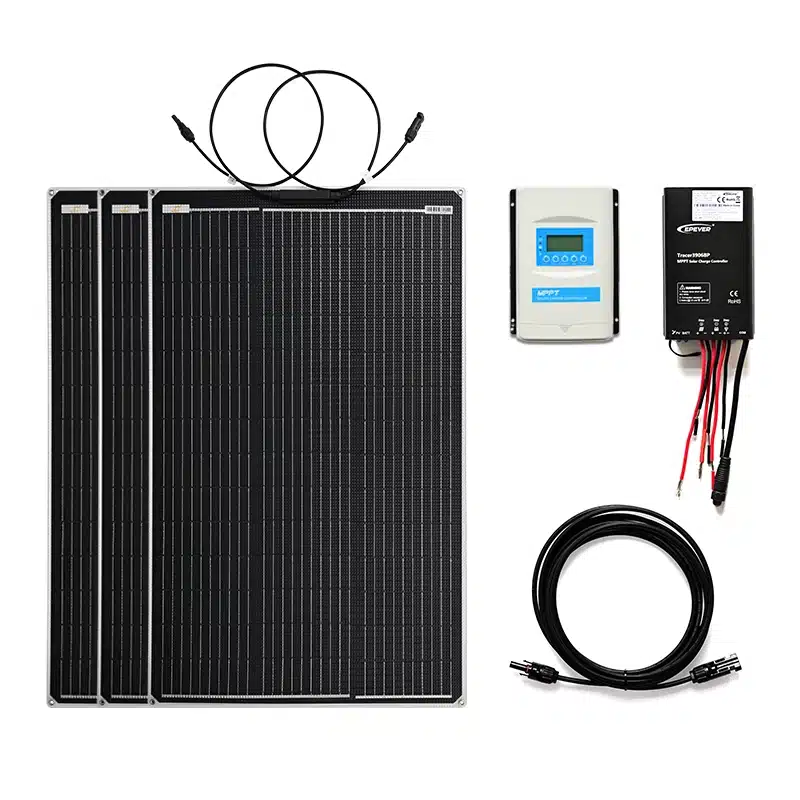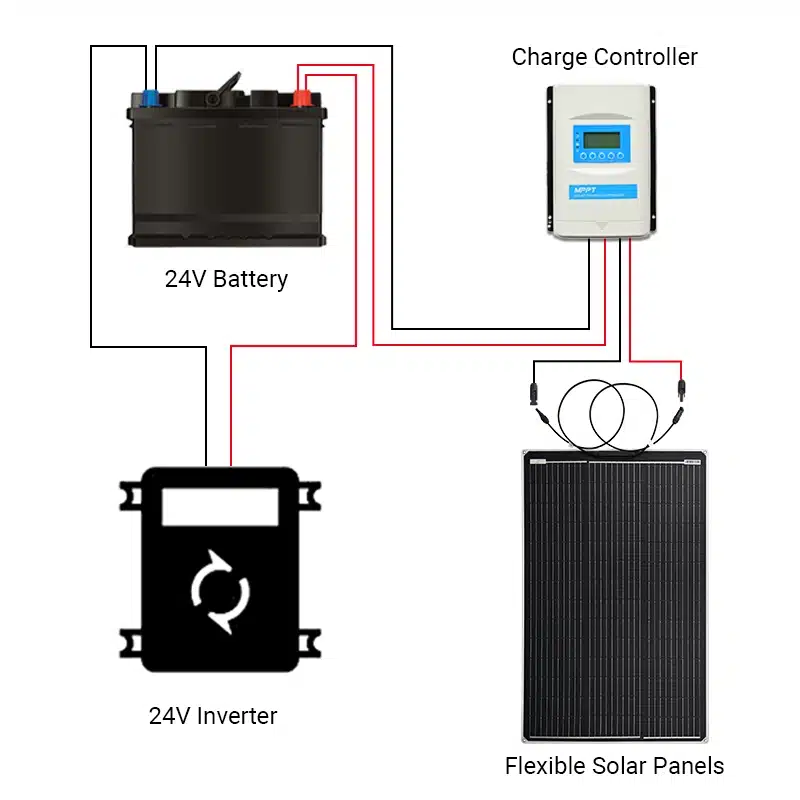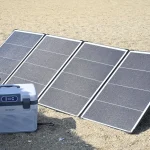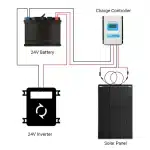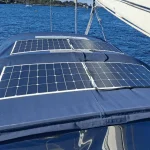How to Use solar battery charger for boat
At Sungold, we are excited about the latest technological advancements in completely changing how boat batteries are charged. You no longer need to worry about returning to shore to power your boat’s batteries because solar panels have become an incredibly convenient solution.
Using solar power to charge boat batteries offers boaters a convenient and eco-friendly solution. Whether you’re enjoying leisurely cruises, fishing trips, or water adventures, having a reliable power source is crucial.
From understanding the feasibility of using solar panels for boat battery charging to selecting the ideal panel size and necessary components, we will cover all the information you need to know about how to use solar panels to charge boat batteries.
Why Use Solar to Charge Boat Batteries?
Modern boats have various applications that rely on electricity for operation. Typically, they are equipped with two batteries: one for starting the engine and another for auxiliary purposes such as trolling. You can charge these batteries using an onboard generator or solar panels.
Investing in marine solar panels is one of the best ways to ensure that your batteries stay charged. The size and power of the solar panels you need will depend on the size and quantity of batteries on your boat. You’ll need to install marine solar panels in a location that receives optimal sunlight, wire the charging station, and add a charge controller.
Additionally, Sungold’s flexible solar panels can serve as additional power sources for onboard equipment that requires electricity. The Sungold LEE series is the perfect portable power solution for your boat. It provides 50-200 watts of power, meaning it can power various appliances and tools on your boat, such as refrigerators, air conditioners, microwaves, phones, laptops, and more.
Indeed, boat batteries can be charged using solar panels. Solar panels are a reliable and eco-friendly solution that can provide power to marine batteries on the water. By harnessing solar energy, solar panels convert it into electricity for charging and maintaining boat batteries.
The real question is: What is the efficiency of using solar panels to charge boat batteries?
The efficiency of solar panels for charging boat batteries is measured by their “full sun” rating, which essentially refers to the length of time the panels are exposed to ample sunlight.
Adequate sunlight means that the panels have been exposed for a sufficient duration to cast sharp shadows. In full sunlight conditions, each square meter of solar panel can generate 1000 watts of power.
Solar panels have been effectively applied to small boats, sailboats, and rowboats. They extend the charging time and, in some cases, can even eliminate the need for engine charging entirely.
There are also significant environmental benefits. Solar panels reduce carbon monoxide in the atmosphere.
So, the next time you’re out boating, enjoying the fresh air in your face and the wind in your hair, remember that solar panels have played a part in making it happen.
Types of Boat Batteries
Boat batteries come in three different types, each named for its specific function, including:
Starting Batteries: These boat batteries are specifically designed for starting or cranking the boat’s engine. While they can provide a burst of power within seconds, it’s only enough to start the boat and cannot sustain its operation.
Deep Cycle Batteries: These high-output batteries have thicker plates and provide additional and steady power for trolling boats and running all equipment, including GPS, lights, and fish finders.
Dual-Purpose Boat Batteries: As the name suggests, these batteries serve the dual roles of starting and solar charger deep cycle batteries. They assist in turning the boat’s engine and keeping it running.
The best part is that marine solar panels can charge all types of boat batteries.
Large-sized solar panels can be used to charge boat batteries.
In general, the ideal size of solar panels for charging boat batteries depends on the amount of power you need and the amount of available sunlight. For most boats, a single 100 watt solar panel is sufficient to maintain the boat’s battery charge in a relatively short time. However, larger boats or those with higher power requirements may require the installation of multiple panels or larger panels.
Let’s assume your boat uses 12V deep cycle marine batteries; in that case, three LEE 100W solar panels would be sufficient to charge them. However, it’s important to remember that 12-volt batteries come in different capacities, ranging from 5 to 200 ampere-hours. So, you should regularly check your battery’s capacity to guide you in purchasing the appropriate solar panels.
Another factor to consider when selecting solar panels for charging boat batteries is the weather conditions during your voyages. If you plan to sail in cloudy and overcast conditions, you may need larger solar panels to compensate for reduced sunlight. On the other hand, if you’ll be sailing in sunny conditions, smaller panels may suffice.
Determining the size of the solar panels for your boat’s batteries can be a complex process. You’ll need to consider several factors, such as the type and capacity of your batteries, how much energy you need to generate, and where you plan to install the panels. Taking all these factors into account should make it easier to choose the right panel size.
The solar panels you choose should be capable of providing enough power to adequately replenish the energy stored in your boat’s batteries. Generally, a solar panel with a rated wattage 30% higher than the battery’s current consumption is suitable for charging it.
Additionally, consider how much energy you need to obtain from the solar panels. Determine how many hours of sunlight you typically receive per day and how much energy each panel can generate. You’ll also need to consider whether you need a single panel or multiple panels to generate more power.
Components Needed for Charging Boat Batteries with Solar Panels
To charge boat batteries using solar panels, you will need the following components:
Solar Panels: You’ll need to understand the type of batteries on your boat to select the appropriate solar panels. For marine solar panels, you may require one or two Sungold LEE series panels to harness the power of the sun and charge the batteries.
Charge Controller: This device helps regulate the flow of energy to the batteries, reducing the risk of overcharging and rapid deterioration.
Battery and Adapter Control Cables: You’ll need power cables to connect the adapters and batteries.
Mounting Hardware: To securely install the solar panels on your boat, you’ll require mounting hardware. This hardware ensures proper positioning of the solar panels to maximize sunlight exposure and maintain stability even in adverse water conditions.
Optional: Adding a battery monitor or energy meter to the system allows you to track the charging progress and monitor the battery’s charge status. These additional components provide valuable information to help you optimize power usage and ensure ample battery charge.
How to Connect Boat Batteries to a Marine Solar Battery Charger
Once you have all the necessary components, you can begin setting up the boat batteries and the marine solar battery charger.
Selecting the Location for Your Marine Solar Battery Charger
Choosing the right location for your marine solar battery charger is crucial to maximize the effectiveness of your charging system. The placement of the charger affects its performance, lifespan, and safety. Here are some tips to consider when selecting a location:
Sunlight: Choose a spot with ample direct sunlight exposure.
Protection: Find a location shielded from wind, rain, and other environmental factors to protect your charger from damage.
Ventilation: Adequate ventilation is needed to help keep the charger cool and reduce the risk of overheating or malfunction.
Accessibility: Opt for a location that is easy to access for maintenance and adjustments.
Safety: Ensure that the chosen location is away from high foot traffic areas or flammable materials, and take all necessary measures to secure the charger to its mounting base.
Basic Steps for Charging Boat Batteries with Solar Power
To charge boat batteries using solar power, you will need solar panels, a solar charge controller, and boat batteries. Solar panels generate electricity from sunlight, while the solar charge controller regulates the flow of current from the solar panels to the batteries to prevent overcharging or undercharging. Here are the basic steps for charging boat batteries with solar power:
Clean Battery Terminals for Effective Charging:
– Disconnect the boat batteries from any power source or devices.
– Use a wire brush to clean the battery terminals, removing any corrosion or dirt.
Select the Right Solar Panels:
– Choose marine solar panels with a rated power output suitable for the size of your batteries and the energy required for charging. For example, a 100-watt solar panel is typically sufficient for a 100 Ah boat battery.
Connect Cables:
– Ensure the use of O-ring terminals or alligator clips. The positive cable (usually red) should be connected to the positive terminal first, followed by the negative cable connected to the other terminal.
Connect the Charge Controller:
– Secure the charge controller in place before connecting the solar panel to the batteries. Connect the battery cables to the respective ports marked positive and negative on the charge controller.
Connect the Solar Panels to the Charge Controller:
– Connect the positive and negative terminals of the solar panels to the corresponding terminals on the charge controller.
Connect the Charge Controller to the Batteries:
– Connect the positive and negative terminals of the panels to the appropriate connectors on the charge controller. Ensure all connections are secure, with no exposed wires. If you have Sungold LEE panels, the grounding pin can be directly connected to the negative terminal on the charge controller. If you have a different type of panel, you may need an additional grounding wire between the panel and the charge controller.
Once all connections are secure, switch on the power button on the charge controller. The LCD screen will display a menu with available settings and options. You can use this menu to adjust the charging parameters according to your specific requirements.
When setting up the solar charge controller, monitor the system regularly to ensure everything is functioning correctly. If any issues arise, be sure to consult Sungold for troubleshooting.
. Monitor the Charging Process:
– The charge controller will regulate the current from the solar panels to the batteries, allowing you to keep the system connected as needed to fully charge the batteries. Monitoring the charging process is crucial to ensure the batteries are not overcharged or undercharged.
Check Indicators:
– Once everything is set up, you should see an indicator showing that the controller is receiving power from the solar panels. If the indicator is not displaying, you must check for any shorts in the system.
How to Disconnect Boat Batteries
To disconnect boat batteries, follow these steps while adhering to safety precautions:
Disconnect the Negative (Black) Cable:
– Remove the negative (black) cable from the negative terminal post of the battery. When removing or inserting any cables, ensure that you grip the metal part of the tool rather than the plastic handle to avoid potential sparks. After disconnecting, place both ends of the negative cable aside.
Disconnect the Positive (Red) Cable:
– Remove the positive (red) cable from the positive terminal post of the battery. Just like before, make sure to grip the metal part of the tool rather than the handle when removing or inserting any cables. Separate both ends of the positive cable from each other and from the negative cable.
Remove the Battery and Place It Safely:
– Take the battery out of its secured location and place it in a safe area. Do not place it in an unsafe location or expose it to hazardous environmental conditions such as extreme temperatures, moisture, or vibrations. If you intend to store it for an extended period, ensure it is stored in a safe, dry place.
Sungold Marine Solar Kits – Flexible Power for Every Journey
At Sungold, we specialize in marine-ready solar solutions built for performance, flexibility, and reliability. Our LEE Series flexible solar panels are lightweight, salt-resistant, and easy to mount on curved surfaces — ideal for boats of all sizes.
🔋 Recommended Combos:
-
TF 100W + 50Ah Battery – For fishing boats or short coastal trips
-
2×TF 100W + 100Ah Battery + MPPT Controller – For weekend cruisers
-
4×TF 100W + 200Ah Storage Kit – For liveaboards or high-demand users
All systems support plug-and-play setup, safe charging, and seamless integration with 12V/24V batteries. Ready to go solar on your boat? Contact Sungold today for a customized solar kit that suits your marine lifestyle.
Conclusion:
Setting up marine solar panels and a charge controller is crucial for maintaining the charge of boat batteries. Please remember to exercise safety precautions when dealing with cables and connectors, and ensure that all connections are properly secured before turning on the power switch.


